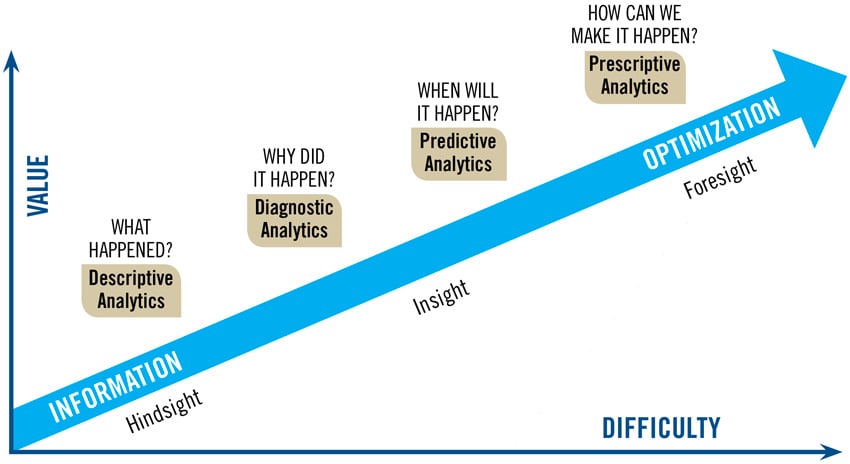Analytics 101–The Four Types of Analytics and Their Uses
As this is a magazine about Information Governance, it behooves us to offer an introduction to analytics. Don’t worry, there won’t be a test. Let’s start with a term that is bandied about in academic and professional circles with reckless abandon: Big Data. Consistently misused, and woefully misunderstood, understanding it, however, can help you get the most out of the analytics we love so much.
Big What?
Big Data analytics has a lot of uses (real-time fraud detection, complex competitive analysis, call center optimization, consumer sentiment analysis, intelligent traffic management, etc.) and has three primary factors: high volume, high velocity, and high variety of data. Analysis of the appropriately named Big Data can provide the kind of insight into relationships and business patterns that can improve a business’ bottom line. The four types of analytics we are most interested in for the purposes of this introduction are:
- Descriptive – Real-time analysis of incoming data
- Diagnostic – Understanding past performance
- Predictive – Forecast of what might happen
- Prescriptive – Formation of rules and recommendations
Descriptive analytics
In many ways, descriptive analytics (or data mining) is the least sophisticated of the bunch. This doesn’t mean that it can’t help provide valuable insight into patterns. Here, we are trying to answer the question: what happened? Not nearly as sexy as predictive or prescriptive analytics, but useful nevertheless. Just as with other types of analytics, raw data is collated from multiple sources in order to provide insight into past behavior. However, the difference here is that the output is binary: was it wrong or right? There is no depth to the data; it provides no explanation. Most data-driven companies go well beyond descriptive analytics, utilizing others to understand the data in order to effect change within their business.
Diagnostic analytics
Diagnostic analytics might be the most familiar to the modern marketer. Often, social media managers track success or failure based on number of posts, new followers (or unfollows), page-views, likes, shares, etc. This is as good of a description of what diagnostic analytics is as anything else. Using this methodology, we are trying to discover why something happened. Comparative statistics here are what drives diagnostic analytics, as we are comparing historical data with another set in order to understand why data looks the way it does. This is why people love Google Analytics so much: it lets them drill down and identify patterns in how visitors interact with their site.
Predictive analytics
Predictive analytics utilizes Big Data to illustrate how patterns in the past can be used to predict the future. Sales is usually a beneficiary of predictive analytics, as lead generation and scoring, along with the sales process itself, is built out of a series of patterns and data points over time. Predictive analytics tells us what is likely to happen based on tendencies and trends, information that makes this forecasting tool so valuable. Bear in mind that statistical models are just estimates. It accuracy is in the continued accruement of data and the refinement of the model based on new information.

Prescriptive analytics
Despite its clear value, and sophistication, prescriptive analytics are not used as often and as widely as it should be. Perhaps it is an insistence on larger, system-wide analytics that makes this narrowly focused body of data overlooked so often. Its purpose is quite simple: what action should be taken in the future to correct a problem or take advantage of a trend. By looking at historical data and external information, a statistical algorithm is created that adds value to a company regardless of its industry.
Take-Home Message
There is no easy conclusion about which one to use. It is dependent on your business scenario. Deploying a combination of analytics types is best to fit the needs of your company. Given the options, companies should choose that blend which provides the greatest return on their investment. Descriptive and diagnostic approaches are reactive; predictive and prescriptive are proactive. The real take-home message is to utilize data-driven analytics to first learn what is happening using descriptive and diagnostic analytics, and to move toward and understanding of what might happen, using predictive and prescriptive analytics. Leveraging Big Data analytics can provide dividends (pun intended) for companies by giving context to their business story, and arming decision-makers with better information, helping to provide a sustainable competitive advantage.
recent posts
You may already have a formal Data Governance program in [...]

